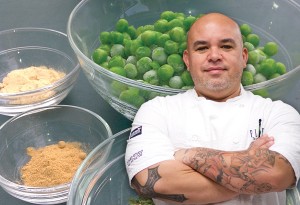Making Your Own Baby Food
 There isn’t a more powerful emotion than holding your child for the first time. I’ve been blessed to experience that remarkable feeling three times over with my children — Roman (7), Mila (5), and Noah (3). When the time came to introduce baby food, my wife and I chose to make our own. This option is certainly healthier for babies and can offer financial savings for your wallet (compared to the expense of jarred food). The nutrition babies consume fuels the building blocks of their immune system, brain development, digestion, and growth of other vital organs. Proper precautions must be taken to prevent the risk of malnutrition, exposure to poor sanitation, or potentially hazardous foods. As a Chef, I focus on healthy family meals with the motto of “1 dish at a time”. But making baby food is so simple that even a baby could do it!
There isn’t a more powerful emotion than holding your child for the first time. I’ve been blessed to experience that remarkable feeling three times over with my children — Roman (7), Mila (5), and Noah (3). When the time came to introduce baby food, my wife and I chose to make our own. This option is certainly healthier for babies and can offer financial savings for your wallet (compared to the expense of jarred food). The nutrition babies consume fuels the building blocks of their immune system, brain development, digestion, and growth of other vital organs. Proper precautions must be taken to prevent the risk of malnutrition, exposure to poor sanitation, or potentially hazardous foods. As a Chef, I focus on healthy family meals with the motto of “1 dish at a time”. But making baby food is so simple that even a baby could do it!
Tips:
- Introductions: Typically your child can start consuming homemade baby food at 4-6 months; however, consult with your pediatrician before introducing it. Add one new ingredient at a time, and always at breakfast or lunch. This will allow the course of the day for observation of any allergic reactions.
- Go natural: If at all, add only a pinch of salt or sugar. Keeping your recipes natural will allow your child to develop a taste for the food without enhancers.
- Color: It is crucial to start with green colored foods, then white, yellow, and lastly, orange. Orange vegetables contain higher amounts of sugar. If your child develops a preferred taste for the sweeter vegetables, they are more apt to not eat any of the other colors. Save the ‘picker eater’ stage for later!
- Safety: Wash your hands, utensils, and cooking equipment before every baby food preparation. These practices will prevent/reduce bacteria growth which could be harmful to your child.
What you need:
- Pot and colander
- Blender or food processor
- Vegetables or fruits
- Simple spices or herbs (if desired)
Method:
- Peel fruit/veggie; chop.
- Boil fruit/veggie until tender. Drain, reserving the now nutrient-rich water to aid with pureeing.
- Transfer into blender or food processor to puree. Use excess water if needed.
- Cool slightly to use immediately. Store in microwavable-safe containers or freeze in resealable bags.
Once your baby has developed a flavor palate, try various cooking techniques to play with different textures, or consider adding fresh herbs and spices (if desired) to your main ingredient mixes. Besides adding flavor, this can introduce other vitamins, minerals, and antioxidants that support the digestive and immune system functions. For example, ginger has been found to aid with diarrhea, nausea, and poor digestion. Turmeric, a very inexpensive spice, is a potent antioxidant which stimulates the gallbladder to release bile to help with fat digestion. Peppermint can also help stomach muscles relax to allow food to pass through the intestines quicker and relieve gas.
TRY THIS RECIPE…
Steamed Peas with Garlic & Ginger
Ingredients:
- 1 cup peas, fresh or frozen (if desired, substitute with other frozen green vegetables)
- ½ tsp ginger powder
- ½ tsp garlic powder
- 1 tsp parsley, freshly minced or dried
Directions:
- Bring 1 cup water to a boil; add peas. Cook 4-6 minutes; then, submerge peas in ice water to halt cooking process (to help preserve nutritional value of vegetable).
- Place peas in blender; add garlic and ginger. Purée well; if needed, add water used during boil to aid blending. Ensure that purée is smooth to avoid any risk of choking.
- Fold in parsley. Serve, or portion and freeze until needed. To thaw, place purée in refrigerator or warm in saucepan with small amount of water.
Chef Rich is committed to fighting childhood obesity “1 dish at a time.” For more information or to explore a hands-on cooking class, visit healthyflame.com, or contact chefrich@healthyflame.com.







